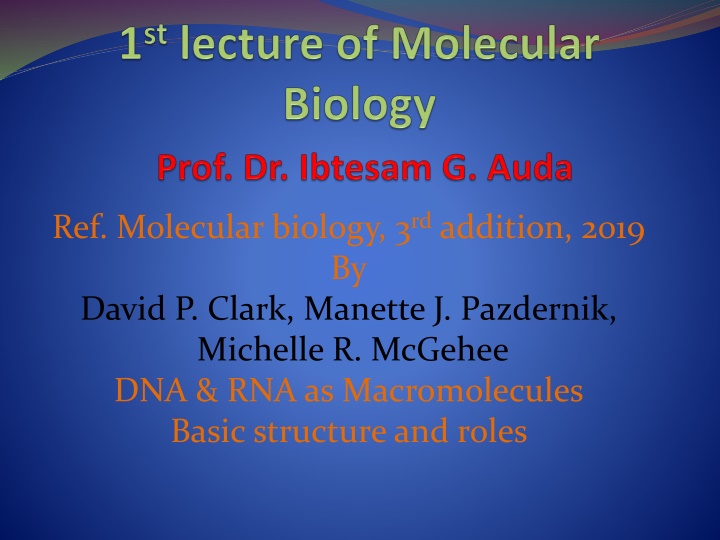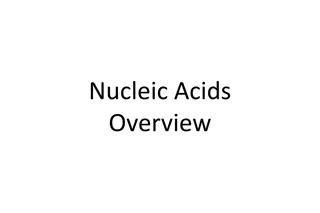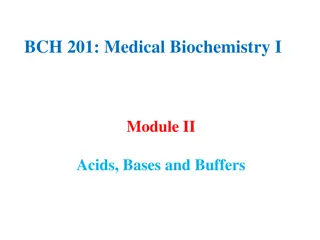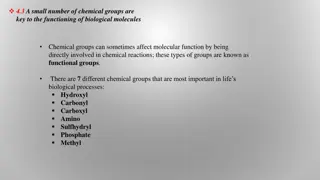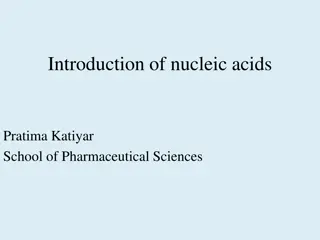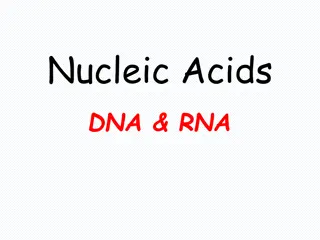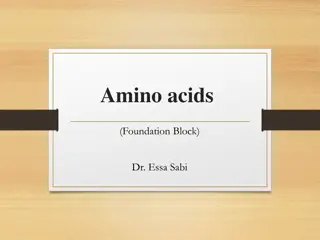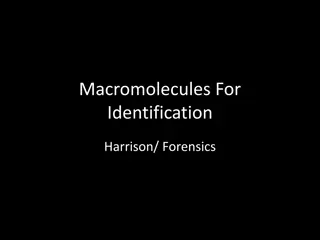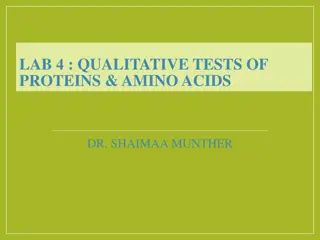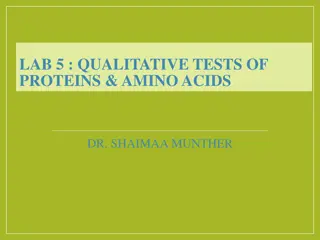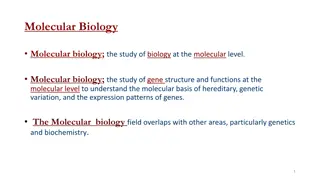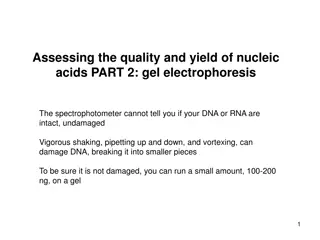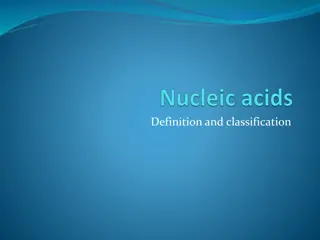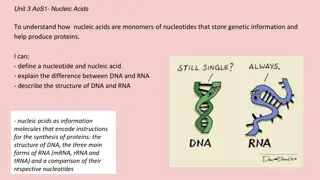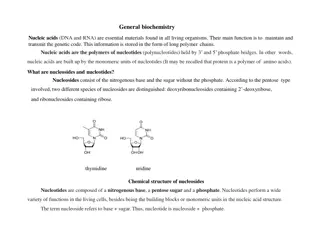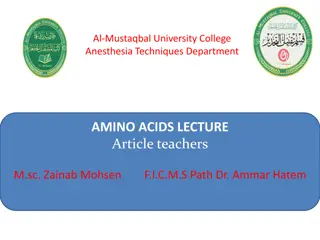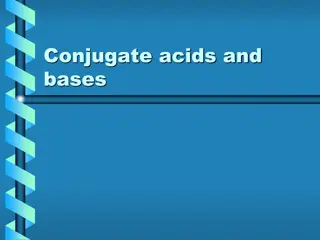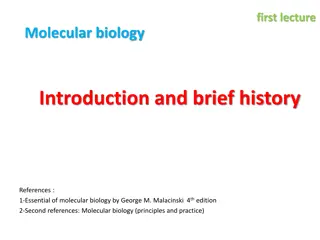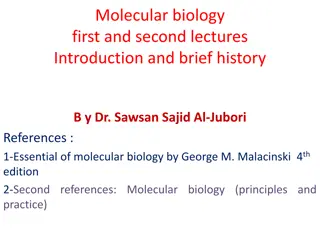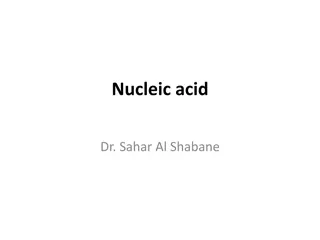Molecular Biology: Nucleic Acids and Their Chemical Structure
Molecular biology delves into the intricate world of macromolecules like DNA, RNA, and proteins to uncover the fundamental processes governing growth, division, and interaction at a molecular level. Nucleic acids, specifically DNA and RNA, play a pivotal role in encoding genetic information. The chemical structure of nucleic acids consists of nucleotides comprising a five-carbon sugar (ribose or deoxyribose), nitrogen bases (purine and pyrimidine), and a phosphate group. Understanding these components is crucial for grasping the essence of genetic information transmission and cellular functioning.
Download Presentation

Please find below an Image/Link to download the presentation.
The content on the website is provided AS IS for your information and personal use only. It may not be sold, licensed, or shared on other websites without obtaining consent from the author.If you encounter any issues during the download, it is possible that the publisher has removed the file from their server.
You are allowed to download the files provided on this website for personal or commercial use, subject to the condition that they are used lawfully. All files are the property of their respective owners.
The content on the website is provided AS IS for your information and personal use only. It may not be sold, licensed, or shared on other websites without obtaining consent from the author.
E N D
Presentation Transcript
Ref. Molecular biology, 3rdaddition, 2019 By David P. Clark, Manette J. Pazdernik, Michelle R. McGehee DNA & RNA as Macromolecules Basic structure and roles
Molecular Biology molecular biology It is the science deals with macromolecules and to understand the patterns(growth , division ,movement and interaction)in terms of the fine molecules responsible for them including (DNA ,RNA and Protein) Types of Macromolecules Nucleic acid :including DNA {Deoxribonucleic acid} & &RNA { Ribonucleic acid}. Proteins Polysaccharid five basic , behaviors specialization
THE NUCLEIC ACIDS : THE NUCLEIC ACIDS : Genetic information is encoded by molecules named nucleic acids because they were originally isolated from the nucleus of eukaryotic cells. There are two related types of nucleic acid, deoxyribonucleic acid (DNA) and ribonucleicacid (RNA). The master copy of each cell s genome is stored on long molecules of DNA, which mayeach contain many thousands of genes. Each gene is thus a linear segment of a long DNA molecule. In contrast, RNA molecules are much shorter, are used to transmit the genetic information to the cell machinery, and carry only one or a few genes. (Certain viruses use RNA to encode their genomes as well as transmitgenetic information to thecell machinery. These RNA viruses have short genomes, rarely more than a dozen genes, as opposed to the hundreds orthousands of genes carried on the DNA genomes of cells.)
Chemical Structure of Nucleic Acids A Nucleic Acid is a polymer consisting from nucleotides (the main structural units in nucleic acid) each nucleotide has the 3 following components: Cyclic five carbon sugar called ribose (in RNA) and as it devoid hydroxyl group attached to carbon no. 2 DNA structure thus it called deoxyribose, Nitrogen base the purine {adenine A and guanine G}and pyrimidine {cytosine C, thymine T and uracil U} .the first type consist from 2 rings while second type contain only one ring . A phosphate group (phosphoric acid) attached to the 5 carbon atom of the sugar by a phosphoester linkage .this phosphate group is responsible for the strong negative charge of nucleicacid
1- Cyclic five carbon sugar Ribose is a single-ring pentose [5-Carbon] sugar. The numbering of the carbon atoms runs clockwise, following organic chemistry rules. Note the absence of the hydroxyl (-OH) group on the 2 carbon in the deoxy-ribose sugar in DNA as compared with the ribose sugar in RNA.
2- Nitrogen bases There are five different types of nitrogenous bases associated with nucleotides. DNA contains the bases adenine, guanine, cytosine, and thymine. These are often abbreviated to A, G, C, and T, respectively. RNA contains A, G, and C, but T is replaced by uracil (U). From the viewpoint of genetic information, T in DNA, and U in RNA are equivalent. The bases found in nucleic acids are of two types, pyrimidines and purines. The smaller pyrimidine bases contain a single ring whereas the purines have a fused double ring. Adenine and guanine are purines; and thymine, uracil and cytosine are pyrimidines. The purine and pyrimidine ring systems and theirderivatives
5 Nitrogen base :the blue nitrogen atom represent the place where the sugar attached to the nitrogen base Nitrogen base in DNA : A T G C without U (Uracile only in RNA) .the back bone is the sugar- phosphate
Carbon no:1 in Sugar attached to nitrogen NO. 9 in case of purine. Carbone no:1 in Sugar attached with nitrogen N0.1 in case of pyramidine
3- the phosphate group: Usually the nucleotide come with 3 phosphate group ( ) when it bind to DNA strand it will lose two groups (pyrophosphate) leafing only one group attached to the helix . The attachment only from one side (the 3 OH free end). the phosphate group is responsible for the strong negative charge of nucleic acid
Conjugated nucleotide (with mono-phosphate group) and non conjugated nucleotide (with tri-phosphate group)
The bonds within the nucleotide A nitrogen base plus a sugar is known nucleoside. base plus a sugar plus phosphate is known nucleotide. as a A as a The bond between base and sugar is N- glycosylic bond the bond between sugar and phosphate is estar bond the bond between 2 bases is hydrogen bond
The attachment always occur from 3 end ,the bond between 2 adjacent nucleotide is called 3 5 phosphodiester bond
Primary structure of DNA The primary structure of DNA represent one single strand ,not branched, result from binding polymer of nucleotides between the 3 OH free end of the upper sugar with the 5 P end (Pe phosphate) of the following nucleotide
According to nitrogen base type the nucleotide is named N.B 1-Adenine Deoxyadenosine Deoxyadenylic acid (d AMP) 2-Cytosine Deoxycytidine Deoxycytidylic (d CMP) 3-Guanine Deoxyguanosine Deoxyguanylic (d GMP) 4-Tymine Deoxythymidine Deoxythymidylic (d TMP) 5- Uracil Uridine Uridylic acid Nucleoside Nucleotide
The secondary structure of DNA The secondary structure of DNA represent by binding two single strand via hydrogen bond A=T and G C. the two strand are anti parallel to each (opposite direction )that is to say 3 end face the 5 end twisted together . Each base pair consists of one larger purine base paired with a smaller pyrimidine base.
The secondary structure of DNA Binding two strand to form double strand
The main difference between DNA and RNA is that the former is double strand while the latter is single strand and Thymine T is replaced by Uracil U. Although RNA is normally single-stranded, many RNA molecules fold up, giving double-stranded regions. In addition, a strand of RNA may be found paired with one of DNA under some circumstances. Furthermore, the genome of certain viruses consists of double-stranded RNA
Maclyn McCarty with Francis Crick and James Watson The Double helix model as proposed by Watson &Crick 1953
Watson and Crick used stick-and-ball models to test their ideas on the possible structure of DNA. They depend on structure conformation shape proposed Rosalind Franklin and Maurice Wilkins, who were using X-ray diffraction to understand the physical structure of the DNA molecule.
What are the differences between DNA and RNA? 1-stracturally 2-functionally 3- types
